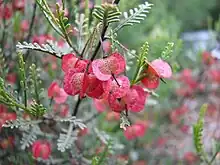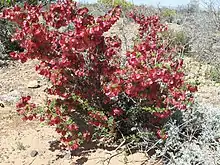Dodonaea microzyga
Dodonaea microzyga, commonly known as brilliant hopbush, is a dioecious spreading shrub in the family Sapindaceae. It grows between 0.3 and 1.5 metres tall.[1][2]
| Dodonaea microzyga | |
|---|---|
 | |
 | |
| Photo: Andrew Walladge | |
| Scientific classification | |
| Kingdom: | Plantae |
| Clade: | Tracheophytes |
| Clade: | Angiosperms |
| Clade: | Eudicots |
| Clade: | Rosids |
| Order: | Sapindales |
| Family: | Sapindaceae |
| Genus: | Dodonaea |
| Species: | D. microzyga |
| Binomial name | |
| Dodonaea microzyga | |
 | |
| Distribution map of Dodonaea microzyga F.Muell. species in Australia | |
Flowering occurs in the months May to July. Flowers are red, solitary or paired, generally with 8 stamen, pubescent ovary and 4 sepals. Flowers develop into a 3-winged glabrous capsule. The fruit capsule is also red and membranous with a septifragal dehiscence, referring to the wings of the capsule breaking open to release seeds. The capsule is elliptical in shape, 10–13 mm long, 10–17 mm wide, with the wings between 2.5-5 mm wide.[3]
Two varieties are recognised:[4]
- D. microzyga var. acrolobata J.G.West (Western Australia) – imparipinnate leaves between 0.6 and 1.2 cm long with 3 or 4 pairs (sometimes 5) of lateral leaflets ranging in length 3.5–8mm, with the terminal lobe-like leaflet shorter than the laterals. Leaves are rarely entire and infrequently toothed or notched.
- D. microzyga F.Muell. var. microzyga – leaves imparipinnate between 0.3 and 0.9 cm long with 2 or 3 pairs of lateral leaflets generally 1.6-3.5mm long. Leaves are entire and rounded or obtuse.
Taxonomy
The species was first formally described by Victorian Government Botanist Ferdinand von Mueller in 1863 based on plant material collected in the vicinity of Neales River in South Australia during an expedition of John McDouall Stuart.[4]
The genus takes its name from the sixteenth century Flemish physician and botanist Rembert Dodoens, who published an illustrated Flemish flora in his Cruydeboek (1554), which was the first to group plants based on shared physical characteristics rather than the established methodology of alphabetical listing.[5]
Distribution and occurrence
Although located in separate areas of Australia, both varieties are located in semi-arid to arid habitats, usually in open woodland or shrubland communities, with D. microzyga F.Muell. var. microzyga preferring stony rises, hills and ranges of ironstone and granite. Widely distributed across South Australia, and extending into southern Northern Territory, western Queensland and far northwestern New South Wales, where it currently has Endangered status. Dodonaea microzyga F.Muell. var. acrolobata is located exclusively in Western Australia, yet is widely distributed in the area between the Murchison region to the north, the Goldfield-Esperance region to the south and east towards the border region of the Great Victoria Desert.[3]
Conservation status
New South Wales is the only State government jurisdiction in Australia with a conservation status applied to D. microzyga F.Muell. var. microzyga which is listed as Endangered. The causes for species decline are attributed to restricted habitat, land clearance and feral goats.[6] Feral goats specifically have been listed by the NSW Scientific Committee as a key threatening process to habitat degradation.[7]
New South Wales has the largest population of feral goats in Australia,[8] preferring the semi-arid rocky rangeland habitats shared with D. microzyga, being more secure from predators and human disturbance than the treeless plains.[6] Dodonaea species (also including D. viscosa and D.attenuata) are palatable to both sheep and goats and are a known forage plant for goats in other states including Western Australia.[3] Although sheep were found not to excessively remove leaf biomass from the plant, feral goats completely defoliate the shrubs resulting in the plants dying.[9]
See also
References
- "Dodonaea microzyga Miq". FloraBase. Western Australian Government Department of Biodiversity, Conservation and Attractions.
- P. G. Wilson & J. A. Scott. "New South Wales Flora Online: Dodonaea microzyga". Royal Botanic Gardens & Domain Trust, Sydney, Australia.
- West, J.G. (1985). Dodonaea, Flora of Australia Volume 25. Canberra, Australia: Australian Government Publishing Service. pp. 144–163. ISBN 0-644-03724-5.
- "Dodonaea microzyga". Australian Plant Name Index (APNI), IBIS database. Centre for Plant Biodiversity Research, Australian Government, Canberra. Retrieved 12 December 2011.
- Jain, Parul (13 December 2011). "Biography of Rembert Dodoens". Encyclopaedia Britannica. Archived from the original on 5 September 2015.
- "Threatened species profile - Brilliant Hopbush". NSW Department of Planning, Industry and Environment. 3 January 2019. Archived from the original on 27 June 2015.
- "Pest animals - Feral goats". NSW Department of Planning, Industry and Environment. 29 July 2018. Archived from the original on 12 July 2018.
- S.A.Khairo, R.B.Hacker, T.L.Atkinson and G.L.Turnball (2013). "Alternative strategies for management of feral goats: implications for natural resource management policies in New South Wales rangelands". The Rangeland Journal. 35 (2): 201–210. doi:10.1071/RJ13020.
{{cite journal}}: CS1 maint: multiple names: authors list (link) - Harrington, G. (1979). "The effects of feral goats and sheep on the shrub populations in a semi-arid woodland". The Rangeland Journal. 1 (4): 334–345. doi:10.1071/RJ9790334 – via www.researchgate.net.
External links
- "Dodonaea microzyga F.Muell". Atlas of Living Australia.
.jpg.webp)
![]() Media related to Dodonaea microzyga at Wikimedia Commons
Media related to Dodonaea microzyga at Wikimedia Commons
